The worst of this strange and unpredictable winter is finally behind us. The winter boat shows are winding down, and the spring shows are just around the corner. Most of our boatshops are reporting a busy winter season.
I stopped by the
Maritime Applied Physics Corporation (MAPC) in Baltimore, MD, and toured the busy boat assembly shop where hull numbers two and three of the new Sagamore water taxis are being built. Although the design of these boats does evoke a traditional draketail, they are longer and broader in the beam than the original workboats.
[gallery columns="2" link="file" size="medium" ids="19129,19130"]
Constructed of aluminum and designed to carry 49 passengers, the initial impression one gets is of a sturdy, workman-like boat that should serve her designed purpose well. The overall configuration does evoke the traditional work boat “floating pickup truck” look, with a small cabin forward and a large, open area aft with a fixed canopy. The reverse raked transom captures exactly the draketail look. Hull number two was leaving for the paint shop, and number three was still upside down on the jigs the day I visited. The prototype taxi was named
Key’s Anthem in honor of Francis Scott Key. According to Nate Baugher, production manager at MAPC, “All the taxis will be named for famous persons or events from Baltimore’s history: Edgar Allen Poe, probably Cal Ripkin, and so on. We hope to have four in service by Preakness weekend.”
Joe Reid reports from Mayo, MD, “Mast and Mallet’s major project this season is a rehab of an interior of a 28-foot Pacemaker. We removed the head and hull liner fabric and exposed a rotten bulkhead in the process. After the bulkhead was replaced, we installed rigid PVC headliner that was CNC routed, to appear as three-inch retro tongue and groove material. The sections were placed in two-foot intervals for future access. Each seam is covered with teak trim for a beam appearance. The PVC sections are painted with Z Spar flat white paint with a hint of brush strokes. CNC routing was done by Harbor Sales in Sudlersville, MD. Completing the overhead and trim, we installed a new teak/ holly plywood floor and steps. Coating on the floor is Interlux Satin varnish. Other work completed is a new transom on a vintage Chris-Craft.”
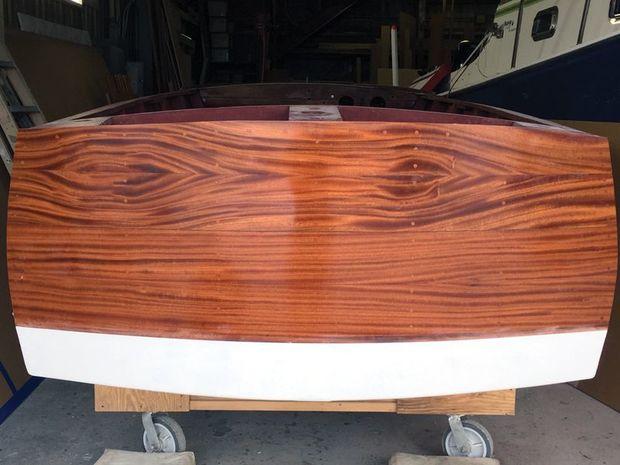 The Patuxent Small Craft Guild (PSCG), the boat shop at the Calvert Marine Museum in Solomons, MD
The Patuxent Small Craft Guild (PSCG), the boat shop at the Calvert Marine Museum in Solomons, MD, has a busy winter schedule of boat building and restoration. One such project is the Montana Guide Boat that is nearing completion. The guide boat was a donation of a stitch-and-glue kit that will likely serve as the guild’s raffle boat for 2017. The 11.5-foot, flat-bottomed craft is ideal for hunting and fishing and weighs around 60 pounds. Designed to carry a hunter and deer, the sturdy okoume hull and deck have been fully filleted and fiberglassed. The lucky winner can stand, sit, or kneel, using oars or pole. See the Guild members at work on Tuesdays and Saturdays from 9 a.m. – 3 p.m.
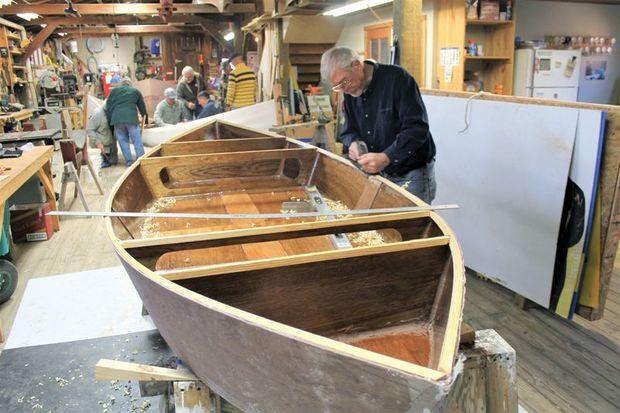 Brit Lilly of Lilly Sport Boats in Arnold, MD
Brit Lilly of Lilly Sport Boats in Arnold, MD, checks in with a fabulous paint job. “We redid a 2009 MTI 42-foot power cat. For power it has twin Mercury Racing 107s with #6 Speed Master drives. The boat runs over 140 miles per hour. The boat was brought to me to restore it back to new. We re-painted the whole boat and clear coated it with Marine Imron. The paint on the boat is all House of Kolors pearl and candy line. We also installed a new interior and cockpit cover.”
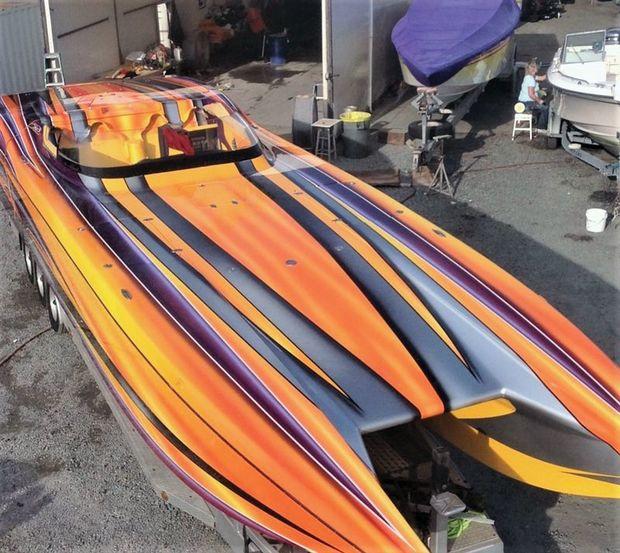 Dave Hannam with Classic Watercraft Restoration in Annapolis
Dave Hannam with Classic Watercraft Restoration in Annapolis reports, “Things are moving forward on the 1938 Century Sea Maid mahogany hull now that all of the deck planking has been cut, and she is ready to have new plugs drilled and installed. Next up, the tedious job of long boarding for her smooth finish. Then onto an install of the 12-volt system, including a new harness to the motor and all new wiring for the dash instruments and switches. Just completed all new mechanical running gear and alignment, so she is ready to turn up. CWR is also working on a 1960 wooden sailboat called
Victoria. She is stripped down to the frame, and we will install a new transom, along with a new cold-molded skin with a finishing cloth, and then paint the outside bright with a nice varnish finish on the interior.
Victoria will be a graduation present to the owner’s daughter this summer—what a great dad!”
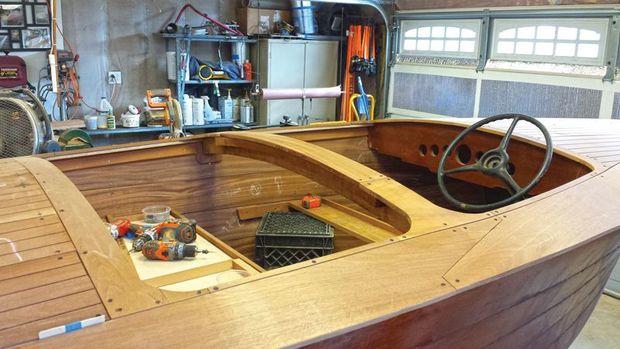 According to Nancy Bray Booth at Hartge Yacht Harbor in Galesville, MD
According to Nancy Bray Booth at Hartge Yacht Harbor in Galesville, MD, “The fiberglass technicians have been occupied all winter removing and replacing wet decks and peeling boat bottoms. As boats age and rot, general deterioration in cored decks can become prevalent. Moisture in the balsa or plywood core will result in spongy decks. Using a moisture meter, taking profiles, and drilling holes tells us what’s really going on under those decks and on the bottom. Deck moisture commonly comes from the area around the hardware, which should be removed and re-bedded on a regular basis during the lifetime of the boat. The rear deck of a Mainship 34 Pilot showed evidence of moisture, and HYH has removed and replaced the rotting balsa with composite material. This compromised area was mostly custom non-skid which had to be removed and replaced. The result is amazing, and the repair is undetectable.
Another customer with a Cape Dory 30 is planning to take the boat to Florida permanently and was concerned with the amount of moisture in the bottom of the boat. After doing some profile spots to determine the extent of the moisture, HYH is peeling off all of the many years of accumulated bottom paint, wet gelcoat, and expired barrier coat. Then we are applying a new barrier coat, and will finish it with bottom paint designed for the waters in Florida. Every boat owner should be concerned about the possibility of invasion of water from the bottom as well as the decks. It’s a worthwhile process to inspect and determine whether or not your boat is in need of some repair. We all know that once water has made its way in where it doesn’t belong, it can be very damaging, and a challenging task to correct. Flaking paint and blisters are indicators that moisture may be present.”
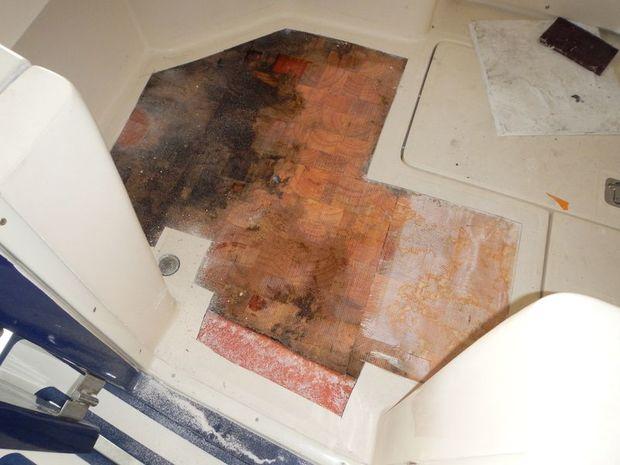 Brandy Whitman from Hartge Yacht Yard in Galesville, MD
Brandy Whitman from Hartge Yacht Yard in Galesville, MD, sends us the following, “Among various boats at our yard this winter, we are working on a Wasque 26 and a Wasque 32. These are exceptionally good-looking boats, originally wood boats built for fishermen, then built of fiberglass by Vineyard Yachts on Martha’s Vineyard, and now built by CW Hood Yachts in Marblehead, MA.
In the 70s or early 80s a number of bare hulls were finished in what is now the Shipwright Harbor Marina in Deale. For the Wasque 32 we are building an aluminum mast for a radar dome that will be powder-coated white. Shortly after, we will start on painting Awlgrip on her decks and cabin. We are in the middle of upgrading the battery and charging system on a Saberline 36 with a high output alternator, smart charger, and large house battery bank. The mechanics are staying busy with fuel tank replacements, engine replacements, and routine jobs such as draining, flushing, and replacing coolant in Detroit 6-71s in a 45-foot Chris-Craft Commander, and a Pacific Seacraft 38 with Caterpillar 3126s.
The carpenters are continuing work on the 1950 Trumpy 55-foot motor yacht. In previous years we rebuilt the bottom of the aft end of the boat which included floors, frames, and blocking deterioration around the fasteners for struts and rudders as well as the planks and frames deteriorated by leaks. We are now removing good planks the length of the boat in order to access frames deteriorated by iron bolts between the frames and the stringers. Wiring and plumbing hidden for many years is now exposed and being replaced as needed. When work is completed,
Manatee should be good for another 67 years.”
[gallery link="file" columns="2" ids="19164,19165"]
George Hazzard of Wooden Boat Restoration in Millington, MD, sends us this report: “We have had a busy winter and a new crew working for me. This past fall I hired Jason Taylor who hails from outside of Richmond, VA. He has been involved in the restoration of the 1950s 13-foot Sears kit boat as well as the re-planking of the 1947 25-foot Chris-Craft Sportsman. We also have Jeff Breza who has been applying fresh varnish to a 1957 22-foot Chris-Craft Sea Skiff, as well as a 1964 17-foot Chris-Craft ski boat. Jared Horn studied at the Landing School before starting work with us in January. He has been applying paint to the 1956 14-foot Penn Yan Captivator as well as helping to make and install spray rails to the 22-foot reproduction Greavette Streamliner. Brooke Ricketts has been working on the new bottom of the 50-foot Ralph Wiley motorsailor. Phil Clayton of Oldies but Goodies Outboards is restoring a 1959 Mercury Mark 58A that is the original motor for the Sears Kit Boat.”
[gallery columns="2" link="file" ids="19168,19167"]
John Patnovic and his crew at Worton Creek Marina in Chestertown, MD, (while online) came across a brand-new, 74-foot Spencer sportfish that had been seriously damaged on rocks near Puerto Rico on a delivery trip to her owner. The boat was being auctioned for salvage. John bid on the boat and won. He hired a crew in Puerto Rico to temporarily patch the bottom and had her towed to St. Thomas and put on a ship for Philadelphia. The boat was relaunched and towed, via the C and D Canal, to Worton Creek. John is working with a surveyor and a naval architect to repair and refit the boat. John estimates the project will take from nine to 12 months, and when she’s complete, “She’ll be better than new.”
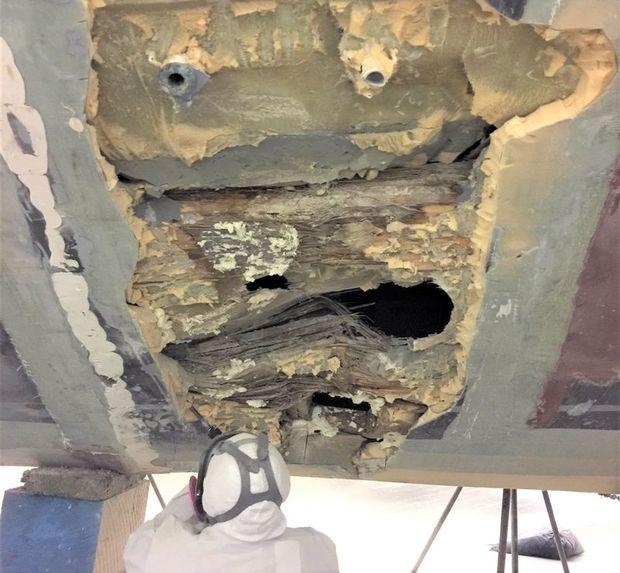 by Capt. Rick Franke
by Capt. Rick Franke The Patuxent Small Craft Guild (PSCG), the boat shop at the Calvert Marine Museum in Solomons, MD, has a busy winter schedule of boat building and restoration. One such project is the Montana Guide Boat that is nearing completion. The guide boat was a donation of a stitch-and-glue kit that will likely serve as the guild’s raffle boat for 2017. The 11.5-foot, flat-bottomed craft is ideal for hunting and fishing and weighs around 60 pounds. Designed to carry a hunter and deer, the sturdy okoume hull and deck have been fully filleted and fiberglassed. The lucky winner can stand, sit, or kneel, using oars or pole. See the Guild members at work on Tuesdays and Saturdays from 9 a.m. – 3 p.m.
The Patuxent Small Craft Guild (PSCG), the boat shop at the Calvert Marine Museum in Solomons, MD, has a busy winter schedule of boat building and restoration. One such project is the Montana Guide Boat that is nearing completion. The guide boat was a donation of a stitch-and-glue kit that will likely serve as the guild’s raffle boat for 2017. The 11.5-foot, flat-bottomed craft is ideal for hunting and fishing and weighs around 60 pounds. Designed to carry a hunter and deer, the sturdy okoume hull and deck have been fully filleted and fiberglassed. The lucky winner can stand, sit, or kneel, using oars or pole. See the Guild members at work on Tuesdays and Saturdays from 9 a.m. – 3 p.m.
 Brit Lilly of Lilly Sport Boats in Arnold, MD, checks in with a fabulous paint job. “We redid a 2009 MTI 42-foot power cat. For power it has twin Mercury Racing 107s with #6 Speed Master drives. The boat runs over 140 miles per hour. The boat was brought to me to restore it back to new. We re-painted the whole boat and clear coated it with Marine Imron. The paint on the boat is all House of Kolors pearl and candy line. We also installed a new interior and cockpit cover.”
Brit Lilly of Lilly Sport Boats in Arnold, MD, checks in with a fabulous paint job. “We redid a 2009 MTI 42-foot power cat. For power it has twin Mercury Racing 107s with #6 Speed Master drives. The boat runs over 140 miles per hour. The boat was brought to me to restore it back to new. We re-painted the whole boat and clear coated it with Marine Imron. The paint on the boat is all House of Kolors pearl and candy line. We also installed a new interior and cockpit cover.”
 Dave Hannam with Classic Watercraft Restoration in Annapolis reports, “Things are moving forward on the 1938 Century Sea Maid mahogany hull now that all of the deck planking has been cut, and she is ready to have new plugs drilled and installed. Next up, the tedious job of long boarding for her smooth finish. Then onto an install of the 12-volt system, including a new harness to the motor and all new wiring for the dash instruments and switches. Just completed all new mechanical running gear and alignment, so she is ready to turn up. CWR is also working on a 1960 wooden sailboat called Victoria. She is stripped down to the frame, and we will install a new transom, along with a new cold-molded skin with a finishing cloth, and then paint the outside bright with a nice varnish finish on the interior. Victoria will be a graduation present to the owner’s daughter this summer—what a great dad!”
Dave Hannam with Classic Watercraft Restoration in Annapolis reports, “Things are moving forward on the 1938 Century Sea Maid mahogany hull now that all of the deck planking has been cut, and she is ready to have new plugs drilled and installed. Next up, the tedious job of long boarding for her smooth finish. Then onto an install of the 12-volt system, including a new harness to the motor and all new wiring for the dash instruments and switches. Just completed all new mechanical running gear and alignment, so she is ready to turn up. CWR is also working on a 1960 wooden sailboat called Victoria. She is stripped down to the frame, and we will install a new transom, along with a new cold-molded skin with a finishing cloth, and then paint the outside bright with a nice varnish finish on the interior. Victoria will be a graduation present to the owner’s daughter this summer—what a great dad!”
 According to Nancy Bray Booth at Hartge Yacht Harbor in Galesville, MD, “The fiberglass technicians have been occupied all winter removing and replacing wet decks and peeling boat bottoms. As boats age and rot, general deterioration in cored decks can become prevalent. Moisture in the balsa or plywood core will result in spongy decks. Using a moisture meter, taking profiles, and drilling holes tells us what’s really going on under those decks and on the bottom. Deck moisture commonly comes from the area around the hardware, which should be removed and re-bedded on a regular basis during the lifetime of the boat. The rear deck of a Mainship 34 Pilot showed evidence of moisture, and HYH has removed and replaced the rotting balsa with composite material. This compromised area was mostly custom non-skid which had to be removed and replaced. The result is amazing, and the repair is undetectable.
Another customer with a Cape Dory 30 is planning to take the boat to Florida permanently and was concerned with the amount of moisture in the bottom of the boat. After doing some profile spots to determine the extent of the moisture, HYH is peeling off all of the many years of accumulated bottom paint, wet gelcoat, and expired barrier coat. Then we are applying a new barrier coat, and will finish it with bottom paint designed for the waters in Florida. Every boat owner should be concerned about the possibility of invasion of water from the bottom as well as the decks. It’s a worthwhile process to inspect and determine whether or not your boat is in need of some repair. We all know that once water has made its way in where it doesn’t belong, it can be very damaging, and a challenging task to correct. Flaking paint and blisters are indicators that moisture may be present.”
According to Nancy Bray Booth at Hartge Yacht Harbor in Galesville, MD, “The fiberglass technicians have been occupied all winter removing and replacing wet decks and peeling boat bottoms. As boats age and rot, general deterioration in cored decks can become prevalent. Moisture in the balsa or plywood core will result in spongy decks. Using a moisture meter, taking profiles, and drilling holes tells us what’s really going on under those decks and on the bottom. Deck moisture commonly comes from the area around the hardware, which should be removed and re-bedded on a regular basis during the lifetime of the boat. The rear deck of a Mainship 34 Pilot showed evidence of moisture, and HYH has removed and replaced the rotting balsa with composite material. This compromised area was mostly custom non-skid which had to be removed and replaced. The result is amazing, and the repair is undetectable.
Another customer with a Cape Dory 30 is planning to take the boat to Florida permanently and was concerned with the amount of moisture in the bottom of the boat. After doing some profile spots to determine the extent of the moisture, HYH is peeling off all of the many years of accumulated bottom paint, wet gelcoat, and expired barrier coat. Then we are applying a new barrier coat, and will finish it with bottom paint designed for the waters in Florida. Every boat owner should be concerned about the possibility of invasion of water from the bottom as well as the decks. It’s a worthwhile process to inspect and determine whether or not your boat is in need of some repair. We all know that once water has made its way in where it doesn’t belong, it can be very damaging, and a challenging task to correct. Flaking paint and blisters are indicators that moisture may be present.”
 Brandy Whitman from Hartge Yacht Yard in Galesville, MD, sends us the following, “Among various boats at our yard this winter, we are working on a Wasque 26 and a Wasque 32. These are exceptionally good-looking boats, originally wood boats built for fishermen, then built of fiberglass by Vineyard Yachts on Martha’s Vineyard, and now built by CW Hood Yachts in Marblehead, MA.
In the 70s or early 80s a number of bare hulls were finished in what is now the Shipwright Harbor Marina in Deale. For the Wasque 32 we are building an aluminum mast for a radar dome that will be powder-coated white. Shortly after, we will start on painting Awlgrip on her decks and cabin. We are in the middle of upgrading the battery and charging system on a Saberline 36 with a high output alternator, smart charger, and large house battery bank. The mechanics are staying busy with fuel tank replacements, engine replacements, and routine jobs such as draining, flushing, and replacing coolant in Detroit 6-71s in a 45-foot Chris-Craft Commander, and a Pacific Seacraft 38 with Caterpillar 3126s.
The carpenters are continuing work on the 1950 Trumpy 55-foot motor yacht. In previous years we rebuilt the bottom of the aft end of the boat which included floors, frames, and blocking deterioration around the fasteners for struts and rudders as well as the planks and frames deteriorated by leaks. We are now removing good planks the length of the boat in order to access frames deteriorated by iron bolts between the frames and the stringers. Wiring and plumbing hidden for many years is now exposed and being replaced as needed. When work is completed, Manatee should be good for another 67 years.”
[gallery link="file" columns="2" ids="19164,19165"]
George Hazzard of Wooden Boat Restoration in Millington, MD, sends us this report: “We have had a busy winter and a new crew working for me. This past fall I hired Jason Taylor who hails from outside of Richmond, VA. He has been involved in the restoration of the 1950s 13-foot Sears kit boat as well as the re-planking of the 1947 25-foot Chris-Craft Sportsman. We also have Jeff Breza who has been applying fresh varnish to a 1957 22-foot Chris-Craft Sea Skiff, as well as a 1964 17-foot Chris-Craft ski boat. Jared Horn studied at the Landing School before starting work with us in January. He has been applying paint to the 1956 14-foot Penn Yan Captivator as well as helping to make and install spray rails to the 22-foot reproduction Greavette Streamliner. Brooke Ricketts has been working on the new bottom of the 50-foot Ralph Wiley motorsailor. Phil Clayton of Oldies but Goodies Outboards is restoring a 1959 Mercury Mark 58A that is the original motor for the Sears Kit Boat.”
[gallery columns="2" link="file" ids="19168,19167"]
John Patnovic and his crew at Worton Creek Marina in Chestertown, MD, (while online) came across a brand-new, 74-foot Spencer sportfish that had been seriously damaged on rocks near Puerto Rico on a delivery trip to her owner. The boat was being auctioned for salvage. John bid on the boat and won. He hired a crew in Puerto Rico to temporarily patch the bottom and had her towed to St. Thomas and put on a ship for Philadelphia. The boat was relaunched and towed, via the C and D Canal, to Worton Creek. John is working with a surveyor and a naval architect to repair and refit the boat. John estimates the project will take from nine to 12 months, and when she’s complete, “She’ll be better than new.”
Brandy Whitman from Hartge Yacht Yard in Galesville, MD, sends us the following, “Among various boats at our yard this winter, we are working on a Wasque 26 and a Wasque 32. These are exceptionally good-looking boats, originally wood boats built for fishermen, then built of fiberglass by Vineyard Yachts on Martha’s Vineyard, and now built by CW Hood Yachts in Marblehead, MA.
In the 70s or early 80s a number of bare hulls were finished in what is now the Shipwright Harbor Marina in Deale. For the Wasque 32 we are building an aluminum mast for a radar dome that will be powder-coated white. Shortly after, we will start on painting Awlgrip on her decks and cabin. We are in the middle of upgrading the battery and charging system on a Saberline 36 with a high output alternator, smart charger, and large house battery bank. The mechanics are staying busy with fuel tank replacements, engine replacements, and routine jobs such as draining, flushing, and replacing coolant in Detroit 6-71s in a 45-foot Chris-Craft Commander, and a Pacific Seacraft 38 with Caterpillar 3126s.
The carpenters are continuing work on the 1950 Trumpy 55-foot motor yacht. In previous years we rebuilt the bottom of the aft end of the boat which included floors, frames, and blocking deterioration around the fasteners for struts and rudders as well as the planks and frames deteriorated by leaks. We are now removing good planks the length of the boat in order to access frames deteriorated by iron bolts between the frames and the stringers. Wiring and plumbing hidden for many years is now exposed and being replaced as needed. When work is completed, Manatee should be good for another 67 years.”
[gallery link="file" columns="2" ids="19164,19165"]
George Hazzard of Wooden Boat Restoration in Millington, MD, sends us this report: “We have had a busy winter and a new crew working for me. This past fall I hired Jason Taylor who hails from outside of Richmond, VA. He has been involved in the restoration of the 1950s 13-foot Sears kit boat as well as the re-planking of the 1947 25-foot Chris-Craft Sportsman. We also have Jeff Breza who has been applying fresh varnish to a 1957 22-foot Chris-Craft Sea Skiff, as well as a 1964 17-foot Chris-Craft ski boat. Jared Horn studied at the Landing School before starting work with us in January. He has been applying paint to the 1956 14-foot Penn Yan Captivator as well as helping to make and install spray rails to the 22-foot reproduction Greavette Streamliner. Brooke Ricketts has been working on the new bottom of the 50-foot Ralph Wiley motorsailor. Phil Clayton of Oldies but Goodies Outboards is restoring a 1959 Mercury Mark 58A that is the original motor for the Sears Kit Boat.”
[gallery columns="2" link="file" ids="19168,19167"]
John Patnovic and his crew at Worton Creek Marina in Chestertown, MD, (while online) came across a brand-new, 74-foot Spencer sportfish that had been seriously damaged on rocks near Puerto Rico on a delivery trip to her owner. The boat was being auctioned for salvage. John bid on the boat and won. He hired a crew in Puerto Rico to temporarily patch the bottom and had her towed to St. Thomas and put on a ship for Philadelphia. The boat was relaunched and towed, via the C and D Canal, to Worton Creek. John is working with a surveyor and a naval architect to repair and refit the boat. John estimates the project will take from nine to 12 months, and when she’s complete, “She’ll be better than new.”
 by Capt. Rick Franke
by Capt. Rick Franke